engine MERCEDES-BENZ C-CLASS ESTATE 2011 User Guide
[x] Cancel search | Manufacturer: MERCEDES-BENZ, Model Year: 2011, Model line: C-CLASS ESTATE, Model: MERCEDES-BENZ C-CLASS ESTATE 2011Pages: 401, PDF Size: 9.74 MB
Page 25 of 401
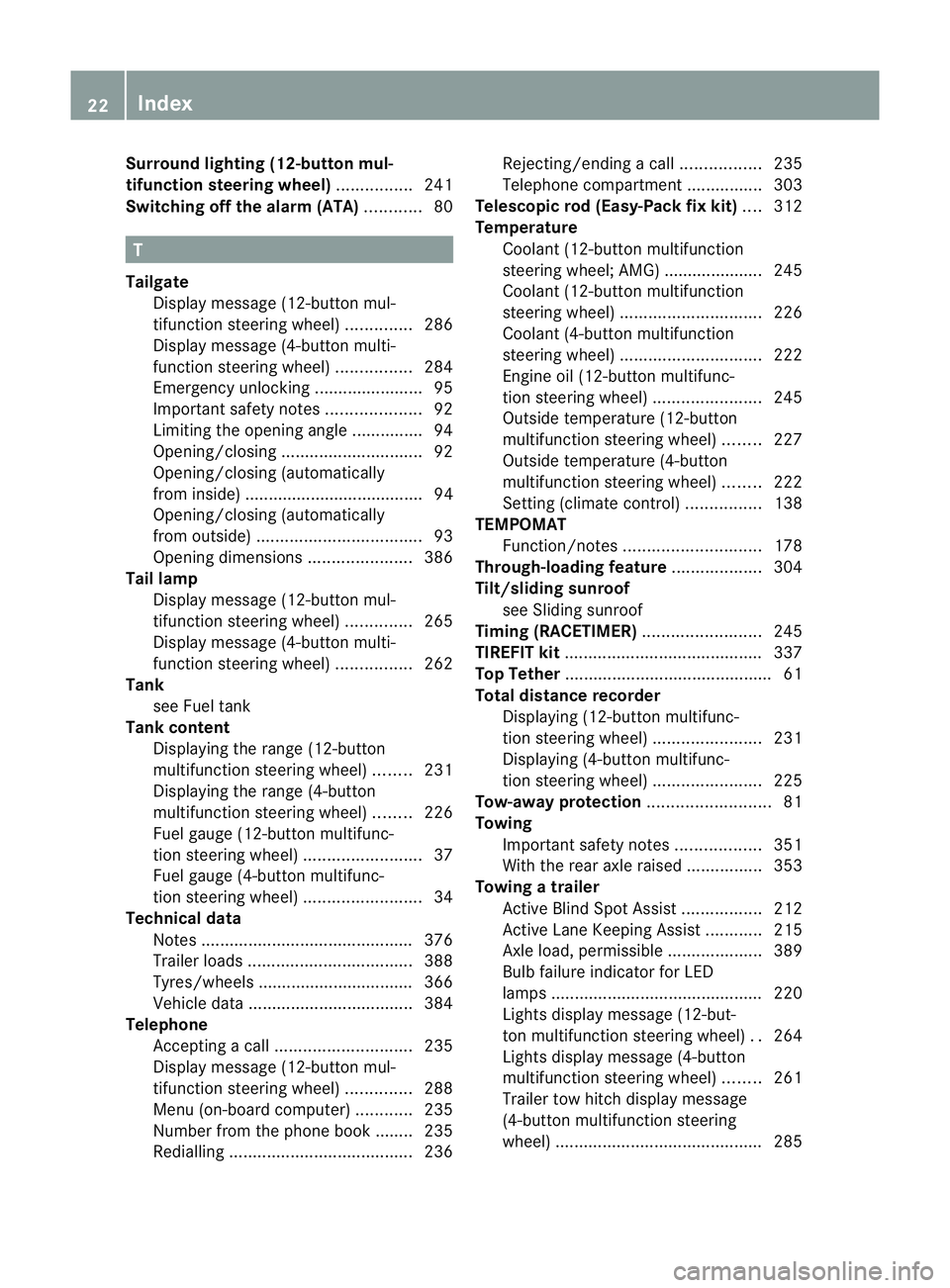
Surround lighting (12-button mul-
tifunction steering wheel)
................241
Switching off the alarm (ATA) ............80 T
Tailgate Display message (12-button mul-
tifunctio nsteering wheel) ..............286
Display message (4-button multi-
function steering wheel) ................284
Emergency unlocking .......................95
Important safety notes ....................92
Limiting the opening angle ...............94
Opening/closing .............................. 92
Opening/closing (automatically
from inside) ...................................... 94
Opening/closing (automatically
from outside) ................................... 93
Opening dimensions ......................386
Tail lamp
Display message (12-button mul-
tifunctio nsteering wheel) ..............265
Display message (4-button multi-
function steering wheel) ................262
Tank
see Fuel tank
Tank content
Displaying the range (12-button
multifunctio nsteering wheel) ........231
Displaying the range (4-button
multifunctio nsteering wheel) ........226
Fuel gauge (12-button multifunc-
tion steering wheel) .........................37
Fuel gauge (4-button multifunc-
tion steering wheel) .........................34
Technical data
Notes ............................................. 376
Trailer loads ................................... 388
Tyres/wheels ................................. 366
Vehicle data ................................... 384
Telephone
Accepting acall............................. 235
Display message (12-button mul-
tifunctio nsteering wheel) ..............288
Menu (on-board computer) ............235
Number from the phone book ....... .235
Redialling ....................................... 236Rejecting/ending
acall................. 235
Telephone compartment ................303
Telescopic rod (Easy-Pac kfix kit) ....312
Temperature Coolant (12-button multifunction
steering wheel; AMG) ..................... 245
Coolant (12-button multifunction
steering wheel) .............................. 226
Coolant (4-button multifunction
steering wheel) .............................. 222
Engine oil (12-button multifunc-
tion steering wheel) .......................245
Outside temperature (12-button
multifunctio nsteering wheel) ........227
Outside temperature (4-button
multifunctio nsteering wheel) ........222
Setting (climate control) ................138
TEMPOMAT
Function/notes ............................. 178
Through-loading feature ...................304
Tilt/sliding sunroof see Sliding sunroof
Timing (RACETIMER) .........................245
TIREFIT kit .......................................... 337
Top Tether ............................................ 61
Total distance recorder Displaying (12-button multifunc-
tion steering wheel) .......................231
Displaying (4-button multifunc-
tion steering wheel) .......................225
Tow-away protection ..........................81
Towing Important safety notes ..................351
With the rear axle raised ................353
Towing atrailer
Activ eBlind Spot Assist .................212
Active Lane Keeping Assist ............215
Axle load, permissible ....................389
Bulb failure indicator for LED
lamps ............................................. 220
Lights display message (12-but-
ton multifunctio nsteering wheel) ..264
Lights display message (4-button
multifunctio nsteering wheel) ........261
Trailer tow hitch display message
(4-button multifunction steering
wheel) ............................................ 28522
Index
Page 26 of 401

Towing away
Fitting the towing ey e.................... 352
Removing the towing eye. ..............353
With both axles on the ground .......353
Tow-starting
Emergency engine starting ............354
Fitting the towing eye. ...................352
Important safety notes ..................351
Removing the towing eye. ..............353
Trailer coupling
see Towing atrailer
Trailer towing
7-pin connector ............................. 220
Blind Spot Assist ............................ 207
Cleaning the trailer tow hitch ......... 331
Coupling up atrailer ...................... 218
Decoupling atrailer ....................... 218
Driving tips .................................... 215
ESP ®
................................................ 77
Folding in the ball coupling ............218
Folding out the ball coupling ..........217
Important safety notes ..................215
Mounting dimensions ....................387
Parking Guidance ........................... 202
Parktroni c...................................... 198
Power supply ................................. 219
Shift range ..................................... 163
Trailer loads ................................... 388
Transmission
see Automatic transmission
see Manual transmission
Transporting the vehicle ..................353
Trim pieces (cleaning instructions) .332
Trip computer On-board computer (12-button
multifunctio nsteering wheel) ........231
On-board computer (4-button
multifunctio nsteering wheel) ........226
Trip meter
Displaying/resetting (4-button
multifunctio nsteering wheel) ........225
Displaying (12-button multifunc-
tion steering wheel) .......................231
Resetting (12-button multifunc-
tion steering wheel) .......................232
Trip odometer
see Trip meter Turn signal
Display message (12-button mul-
tifunctio nsteering wheel) ..............265
Display message (4-button multi-
function steering wheel) ................262
Turn signals
Switching on/off ........................... 120
Two-way radio
Frequencies ................................... 377
Installatio n..................................... 377
Transmission output (maximum) .... 377
Type identification plate
see Vehicle identification plate
Tyre pressure
Calling up (on-board computer) .....363
Display message (12-button mul-
tifunctio nsteering wheel) ..............281
Display message (4-button multi-
function steering wheel) ................280
Not reached (TIREFIT) ....................340
Pressure loss warning ....................362
Reached (TIREFIT) ..........................340
Recommended ............................... 361
Tyre pressure monitor
Function/notes ............................. 363
Restarting ...................................... 365
Warning lamp ................................. 300
Tyres
Checking ........................................ 358
Directio nofrotation ...................... 366
Display message (12-button mul-
tifunction steering wheel) ..............281
Display message (4-button multi-
function steering wheel) ................280
Grip ................................................ 177
Important safety notes ..................358
Replacing ....................................... 365
Service life ..................................... 359
Storing ........................................... 366
Tyr esize (data) .............................. 366
Tyr etread ...................................... 359
see Flat tyre Index
23
Page 29 of 401

Protection of the environment
Notes
H
Environmental note
Daimler's declared policy is one of integrated
environmental protection.
The objectives are for the natural resources
which form the basis of our existence on this
planet to be used sparingly and in a manner
which takes the requirements of both nature
and humanity into account.
You too can help to protect the environment
by operating your vehicle in an environmen-
tally responsible manner.
Fuel consumption and the rate of engine,
transmission, brake and tyre wear depend on
the following factors:
R operating conditions of your vehicle
R your personal driving style
You can influence both factors. You should
bear the following in mind:
Operating conditions:
R avoid short trips as these increase fuel con-
sumption.
R make sure that the tyre pressures are
always correct.
R do not carry any unnecessary weight.
R keep an eye on the vehicle's fuel consump-
tion.
R remove roof racks once you no longer need
them.
R a regularly serviced vehicle will contribute
to environmental protection. You should
therefore adhere to the service intervals.
R always have maintenance work carried out
at a qualified specialist workshop, e.g. a
Mercedes-Benz Service Centre.
Personal driving style:
R do not depress the accelerator pedal when
starting the engine.
R do not warm up the engine with the vehicle
stationary. R
drive carefully and maintain a safe distance
from the vehicle in front.
R avoid frequent, sudden acceleration.
R change gear in good time and use each gear
only up to Ôof its maximum engine speed.
R switch off the engine in stationary traffic. Returning end-of-life vehicles
Mercedes-Benz will take back your
Mercedes-Benz to dispose of it in an environ-
mentally responsible manner, in accordance
with the European Union (EU) End of Life
Vehicles Directive.
The End of Life Vehicles Directive applies to
vehicles with a gross vehicle weight of up to
3.5 t, in accordance with national regulations.
For several years, Mercedes-Benz has been
meeting all the legal requirements for a
design which allows for recycling and reuse.
There is a network of return points and dis-
assembly plants which can recycle your vehi-
cle in an environmentally responsible man-
ner. The options for recycling vehicles and
parts are constantly being developed and
improved. This means that your Mercedes-
Benz will also continue to meet even the
increased recycling quotas in the future in
good time. You can obtain further information
from your national Mercedes-Benz homepage
or your national hotline number. Vehicle equipment
This Owner's Manual describes all models
and all standard and optional equipment of
your vehicle available at the time of publica-
tion of the Owner's Manual. Country-specific
differences are possible. Please note that
your vehicle may not be equipped with all fea-
tures described. This also applies to safety-
relevant systems and functions. The equip-
ment in your vehicle may therefore differ from
that shown in the descriptions and illustra-
tions. All the systems found in your vehicle 26
Introduction
Page 30 of 401
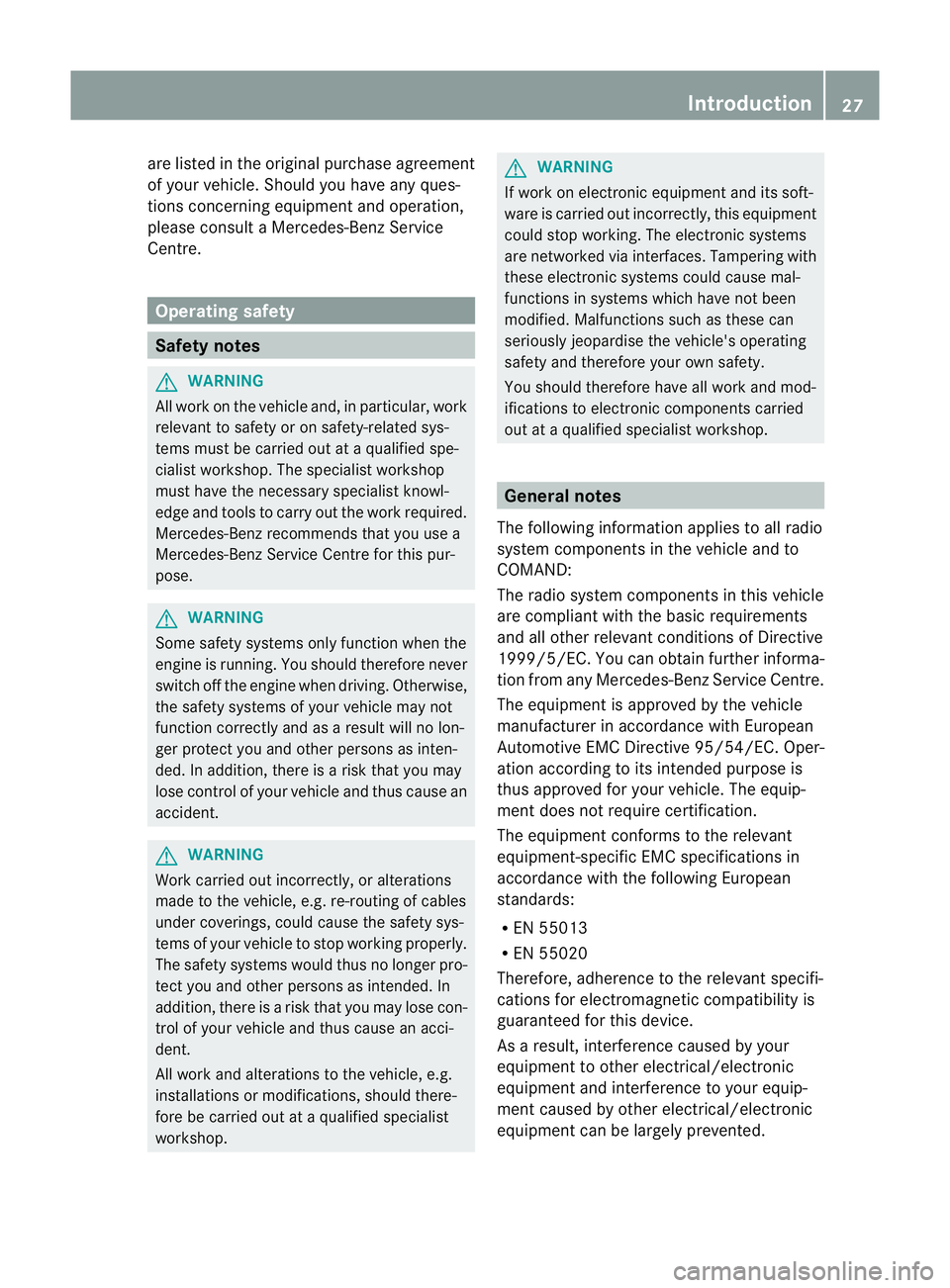
are listed in the original purchase agreement
of your vehicle .Should you have any ques-
tions concerning equipment and operation,
please consult a Mercedes-Ben zService
Centre. Operating safety
Safety notes
G
WARNING
All work on the vehicle and, in particular, work
relevant to safety or on safety-related sys-
tems must be carried out at a qualified spe-
cialist workshop. The specialist workshop
must have the necessary specialist knowl-
edge and tools to carry out the work required.
Mercedes-Benz recommends that you use a
Mercedes-Benz Service Centre for this pur-
pose. G
WARNING
Some safety systems only function when the
engine is running. You should therefore never
switch off the engine when driving. Otherwise,
the safety systems of your vehicle may not
function correctly and as a result will no lon-
ger protec tyou and other persons as inten-
ded. In addition, there is a risk that you may
lose control of your vehicle and thus cause an
accident. G
WARNING
Work carried out incorrectly, or alterations
made to the vehicle, e.g. re-routing of cables
under coverings, could cause the safety sys-
tems of your vehicle to stop working properly.
The safety systems would thus no longer pro-
tect you and other persons as intended. In
addition, there is a risk that you may lose con-
trol of your vehicle and thus cause an acci-
dent.
All work and alterations to the vehicle, e.g.
installations or modifications, should there-
fore be carried out at aqualified specialist
workshop. G
WARNING
If work on electronic equipment and its soft-
ware is carried out incorrectly, this equipment
could stop working .The electronic systems
are networked via interfaces. Tampering with
these electronic systems could cause mal-
functions in systems which have not been
modified. Malfunctions such as these can
seriously jeopardise the vehicle's operating
safety and therefore your own safety.
You should therefore have all work and mod-
ifications to electronic components carried
out at a qualified specialist workshop. General notes
The following information applies to all radio
system components in the vehicle and to
COMAND:
The radio system components in this vehicle
are compliant with the basic requirements
and all other relevant conditions of Directive
1999/5/EC. You can obtain further informa-
tion from any Mercedes-Benz Service Centre.
The equipment is approved by the vehicle
manufacturer in accordance with European
Automotive EMC Directive 95/54/EC. Oper-
ation according to its intended purpose is
thus approved for your vehicle. The equip-
ment does not require certification.
The equipment conforms to the relevant
equipment-specific EMC specifications in
accordance with the following European
standards:
R EN 55013
R EN 55020
Therefore, adherence to the relevant specifi-
cations for electromagnetic compatibility is
guaranteed for this device.
As a result, interference caused by your
equipment to other electrical/electronic
equipment and interference to your equip-
ment caused by other electrical/electronic
equipment can be largely prevented. Introduction
27 Z
Page 31 of 401
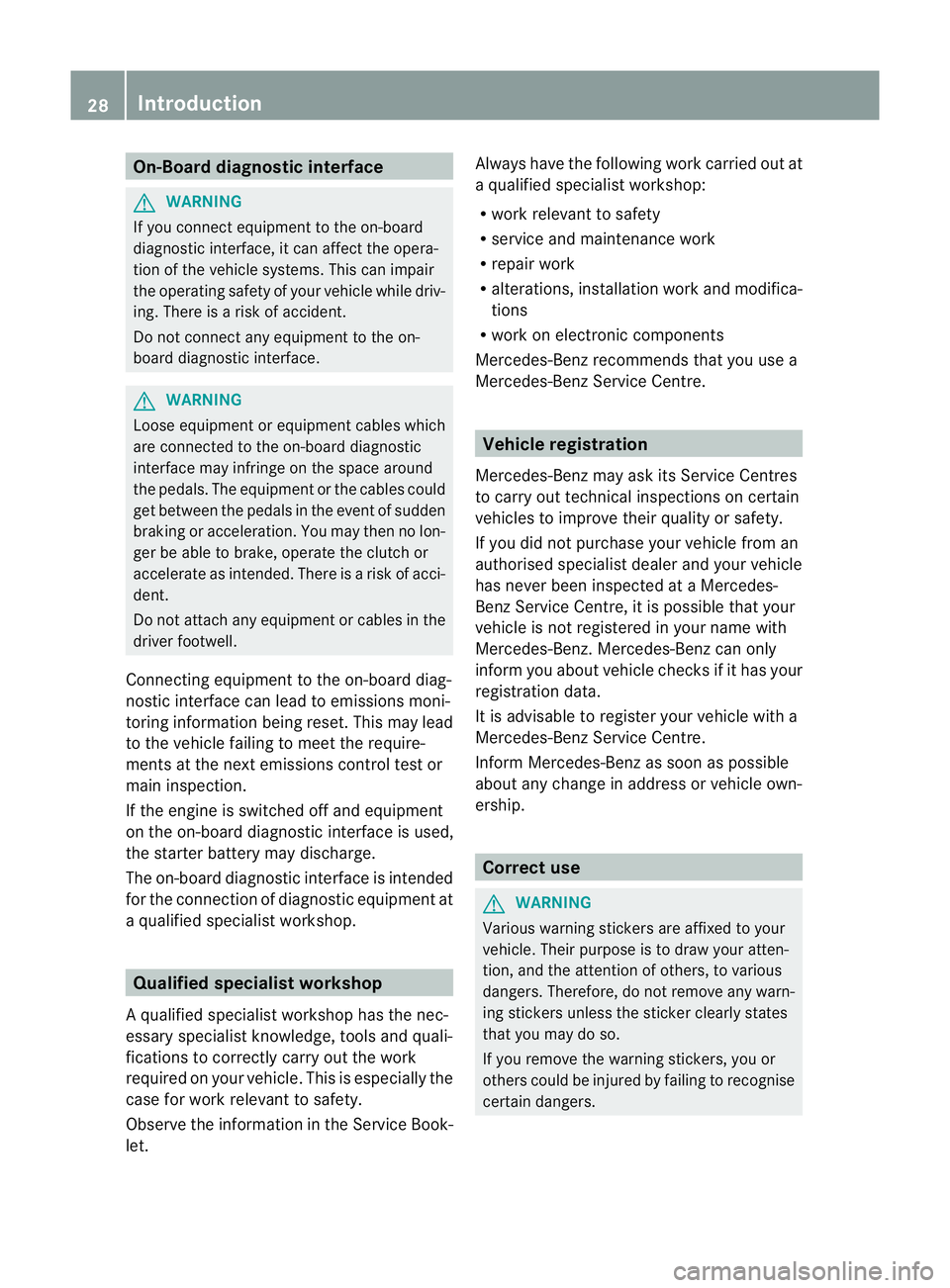
On-Board diagnostic interface
G
WARNING
If you connect equipment to the on-board
diagnostic interface, it can affect the opera-
tion of the vehicle systems. This can impair
the operating safety of your vehicle while driv-
ing. There is a risk of accident.
Do not connect any equipment to the on-
board diagnostic interface. G
WARNING
Loose equipment or equipment cables which
are connected to the on-board diagnostic
interface may infringe on the space around
the pedals. The equipment or the cables could
get between the pedals in the event of sudden
braking or acceleration. You may then no lon-
ger be able to brake, operate the clutch or
accelerate as intended. There is a risk of acci-
dent.
Do not attach any equipment or cables in the
driver footwell.
Connecting equipment to the on-board diag-
nostic interface can lead to emissions moni-
toring information being reset .This may lead
to the vehicle failing to meet the require-
ments at the next emissions control test or
main inspection.
If the engine is switched off and equipment
on the on-board diagnostic interface is used,
the starter battery may discharge.
The on-board diagnostic interface is intended
for the connection of diagnostic equipment at
a qualified specialist workshop. Qualified specialist workshop
Aq ualified specialist workshop has the nec-
essary specialist knowledge, tools and quali-
fications to correctl ycarry out the work
required on your vehicle .This is especially the
case for work relevant to safety.
Observe the information in the Service Book-
let. Always have the following work carried out at
a qualified specialist workshop:
R
work relevant to safety
R service and maintenance work
R repair work
R alterations, installation work and modifica-
tions
R work on electronic components
Mercedes-Ben zrecommends that you use a
Mercedes-Benz Service Centre. Vehicle registration
Mercedes-Benz may ask its Service Centres
to carry out technical inspections on certain
vehicles to improve their quality or safety.
If you did not purchase your vehicle from an
authorised specialist dealer and your vehicle
has never been inspected at a Mercedes-
BenzS ervice Centre, it is possible that your
vehicle is not registered in your name with
Mercedes-Benz. Mercedes-Benz can only
infor myou about vehicle checks if it has your
registration data.
It is advisable to register your vehicle with a
Mercedes-Benz Service Centre.
InformM ercedes-Benza s soon as possible
abouta ny change in address or vehicle own-
ership. Correc
tuse G
WARNING
Various warning stickers are affixed to your
vehicle. Their purpose is to draw your atten-
tion, and the attention of others, to various
dangers. Therefore, do not remove any warn-
ing stickers unless the sticker clearly states
that you may do so.
If you remove the warning stickers, you or
others could be injured by failing to recognise
certain dangers. 28
Introduction
Page 39 of 401
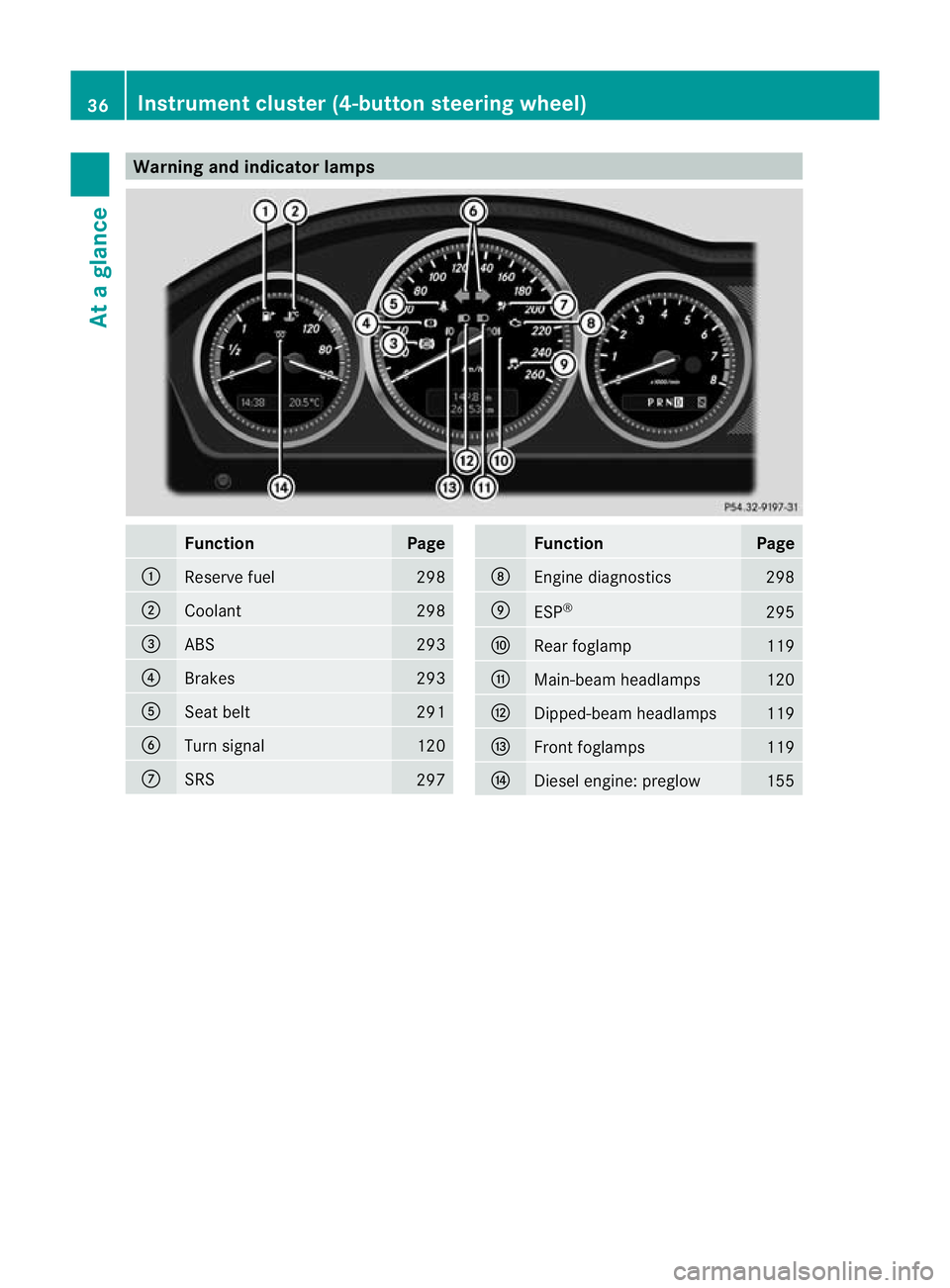
Warning and indicator lamps
Function Page
:
Reserve fuel 298
;
Coolant 298
=
ABS 293
?
Brakes 293
A
Seat belt 291
B
Turn signal 120
C
SRS
297 Function Page
D
Engine diagnostics 298
E
ESP
® 295
F
Rea
rfoglamp 119
G
Main-beam headlamps 120
H
Dipped-beam headlamps 119
I
Front foglamps 119
J
Diesel engine: preglow 15536
Instrument cluster (4-button steering wheel)At a glance
Page 42 of 401
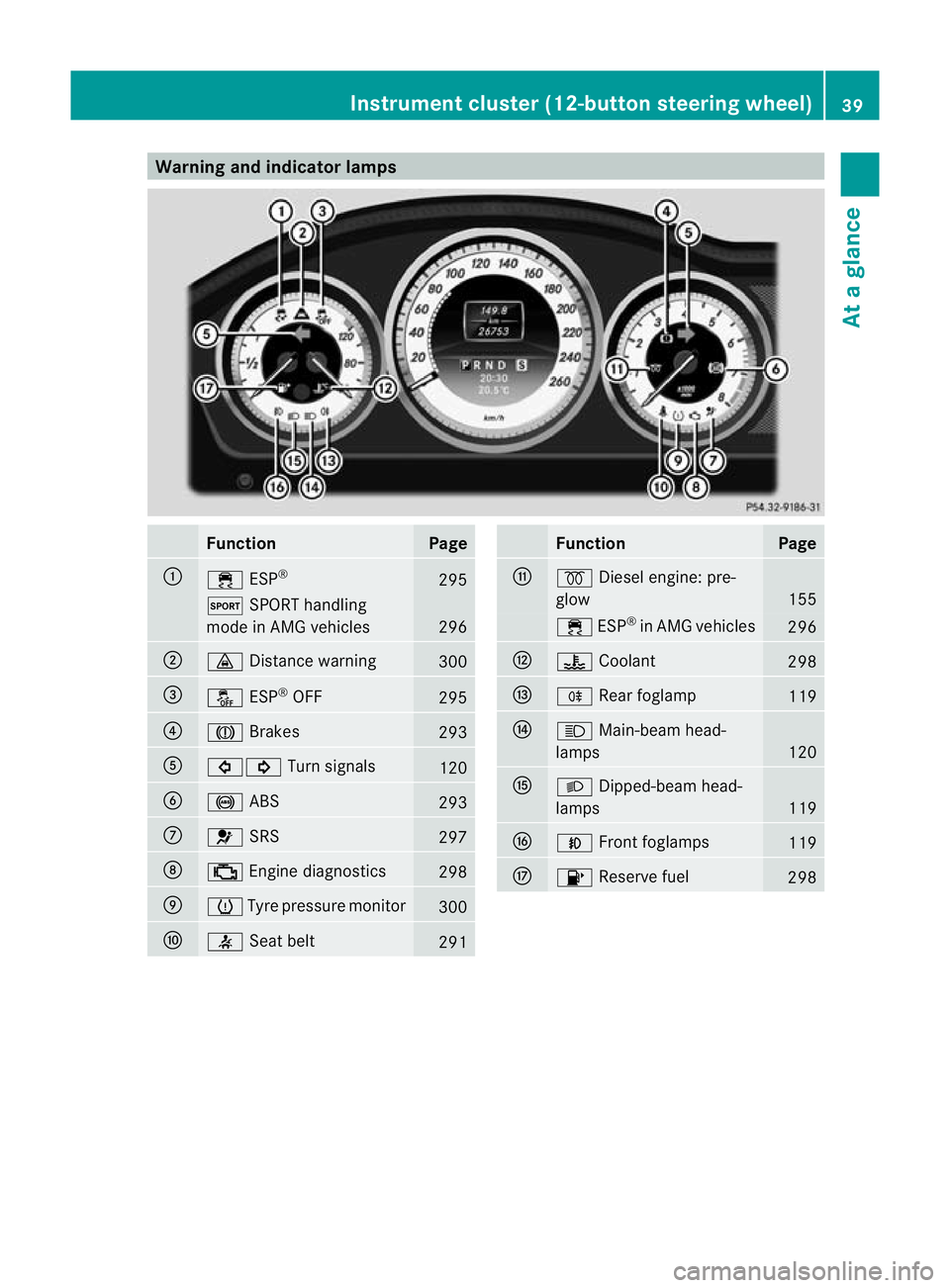
Warning and indicator lamps
Function Page
:
÷
ESP® 295
M
SPORT handling
mode in AMG vehicles 296
;
·
Distance warning 300
=
å
ESP®
OFF 295
?
J
Brakes 293
A
#!
Turn signals 120
B
!
ABS 293
C
6
SRS 297
D
;
Engine diagnostics 298
E
h
Tyre pressure monitor 300
F
7
Seat belt 291 Function Page
G
%
Diesel engine: pre-
glow 155
÷
ESP®
in AMG vehicles 296
H
?
Coolant 298
I
R
Rearfoglamp 119
J
K
Main-beam head-
lamps 120
K
L
Dipped-beam head-
lamps 119
L
N
Front foglamps 119
M
8
Reserve fuel 298Instrument cluster (12-button steering wheel)
39At a glance
Page 50 of 401
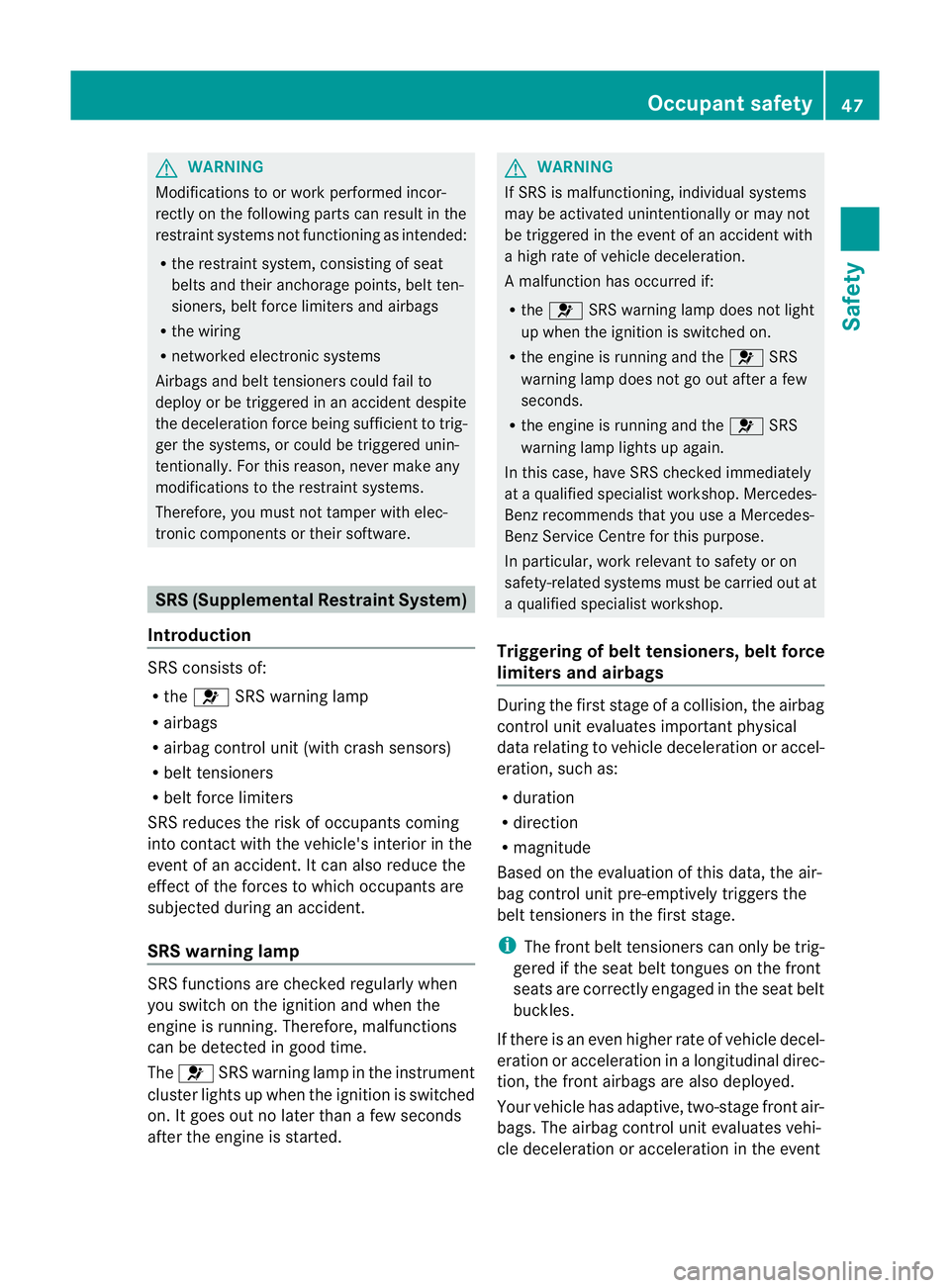
G
WARNING
Modifications to or work performed incor-
rectly on the following parts can result in the
restraint systems not functioning as intended:
R the restraint system, consisting of seat
belts and their anchorage points, beltt en-
sioners, belt force limiters and airbags
R the wiring
R networked electronic systems
Airbags and belt tensioners could fail to
deploy or be triggered in an acciden tdespite
the deceleration force being sufficien tto trig-
ger the systems, or could be triggered unin-
tentionally. For this reason, never make any
modifications to the restraint systems.
Therefore, you must not tamper with elec-
tronic components or their software. SRS (Supplemental Restraint System)
Introduction SRS consists of:
R
the 6 SRS warning lamp
R airbags
R airbag control unit (with crash sensors)
R belt tensioners
R belt force limiters
SRS reduces the risk of occupants coming
into contact with the vehicle's interior in the
event of an accident. It can also reduce the
effect of the forces to which occupants are
subjected during an accident.
SRS warning lamp SRS functions are checked regularly when
you switch on the ignition and when the
engine is running. Therefore, malfunctions
can be detected in good time.
The 6 SRS warning lamp in the instrument
cluster lights up when the ignition is switched
on. It goes out no later than a few seconds
after the engine is started. G
WARNING
If SRS is malfunctioning, individual systems
may be activated unintentionally or may not
be triggered in the event of an accident with
a high rate of vehicle deceleration.
A malfunction has occurred if:
R the 6 SRS warning lamp does not light
up when the ignition is switched on.
R the engine is running and the 6SRS
warning lamp does not go out after a few
seconds.
R the engine is running and the 6SRS
warning lamp lights up again.
In this case, have SRS checked immediately
at a qualified specialist workshop. Mercedes-
Benz recommends that you use a Mercedes-
Benz Service Centre for this purpose.
In particular, work relevant to safety or on
safety-related systems must be carried out at
a qualified specialist workshop.
Triggering of belt tensioners, belt force
limiters and airbags During the first stage of a collision, the airbag
control unit evaluates important physical
data relating to vehicle deceleration or accel-
eration, such as:
R
duration
R direction
R magnitude
Based on the evaluation of this data, the air-
bag control unit pre-emptively triggers the
belt tensioners in the first stage.
i The front belt tensioners can only be trig-
gered if the seat belt tongues on the front
seats are correctly engaged in the seat belt
buckles.
If there is an even higher rate of vehicle decel-
eration or acceleration in a longitudinal direc-
tion, the front airbags are also deployed.
Your vehicle has adaptive, two-stage front air-
bags. The airbag control unit evaluates vehi-
cle deceleration or acceleration in the event Occupant safety
47Safety Z
Page 59 of 401
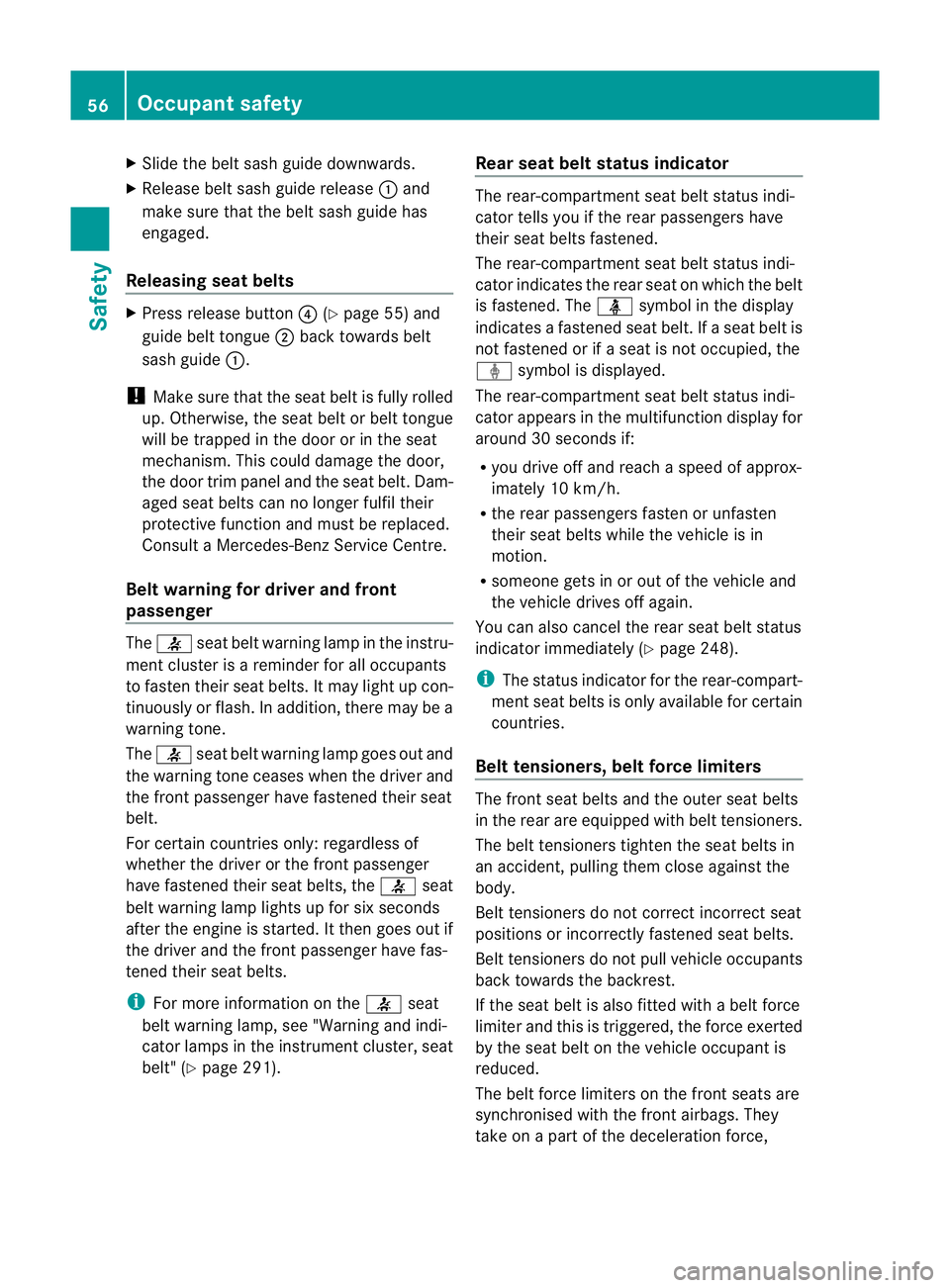
X
Slide the belt sash guide downwards.
X Release belt sash guide release :and
make sure tha tthe belt sash guide has
engaged.
Releasing seat belts X
Press release button ?(Ypage 55) and
guide belt tongue ;back towards belt
sash guide :.
! Make sure that the seat belt is fully rolled
up. Otherwise, the seat belt or belt tongue
will be trapped in the door or in the seat
mechanism. This could damage the door,
the door trim panel and the seat belt. Dam-
aged seat belts can no longer fulfil their
protective function and must be replaced.
Consult a Mercedes-Ben zService Centre.
Belt warning for driver and front
passenger The
7 seat belt warning lamp in the instru-
ment cluster is a reminder for all occupants
to fasten their seat belts. It may light up con-
tinuously or flash. In addition, there may be a
warning tone.
The 7 seat belt warning lamp goes out and
the warning tone ceases when the driver and
the fron tpassenger have fastened their seat
belt.
For certain countries only: regardless of
whether the driver or th efront passenger
have fastened their seat belts, the 7seat
beltw arning lamp lights up for six seconds
after the engine is started. It then goes out if
the driver and the fron tpassenger have fas-
tened their seat belts.
i For more information on the 7seat
belt warning lamp, see "Warning and indi-
cator lamps in the instrumen tcluster, seat
belt" (Y page 291). Rear seat belt status indicator The rear-compartmen
tseat belt status indi-
cator tells you if the rear passengers have
their seat belts fastened.
The rear-compartment seat belt status indi-
cator indicates the rear seat on which the belt
is fastened. The üsymbol in the display
indicates a fastened seat belt. If a seat belt is
not fastened or if a seat is not occupied, the
ý symbol is displayed.
The rear-compartment seat belt status indi-
cator appears in the multifunction display for
around 30 seconds if:
R you drive off and reach a speed of approx-
imately 10 km/h.
R the rear passengers fasten or unfasten
their seat belts while the vehicle is in
motion.
R someone gets in or out of the vehicle and
the vehicle drives off again.
You can also cancel the rear seat belt status
indicator immediately (Y page 248).
i The status indicator for the rear-compart-
ment seat belts is only available for certain
countries.
Belt tensioners, belt force limiters The fron
tseat belts and the outer seat belts
in the rear are equipped with belt tensioners.
The belt tensioners tighten the seat belts in
an accident, pulling them close against the
body.
Belt tensioners do not correct incorrect seat
positions or incorrectly fastened seat belts.
Belt tensioners do not pull vehicle occupants
back towards the backrest.
If the seat belt is also fitted with a belt force
limiter and this is triggered, the force exerted
by the seat belt on the vehicle occupan tis
reduced.
The belt force limiters on the front seats are
synchronised with the front airbags. They
take on a part of the deceleration force, 56
Occupant safetySafety
Page 78 of 401
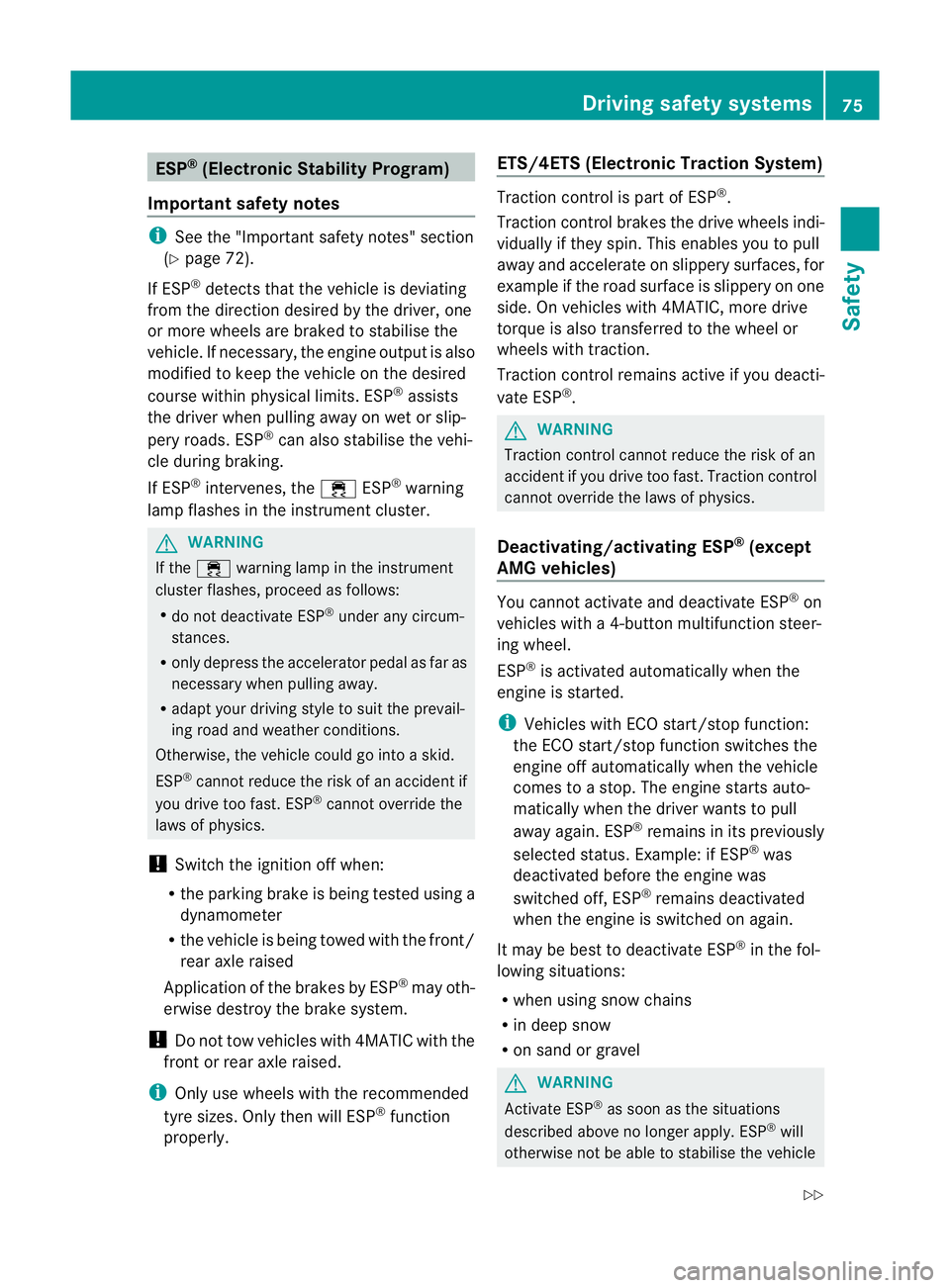
ESP
®
(Electronic Stability Program)
Important safety notes i
See the "Important safety notes" section
(Y page 72).
If ESP ®
detects that the vehicle is deviating
from the direction desired by the driver, one
or more wheels are braked to stabilise the
vehicle .Ifnecessary, the engine output is also
modified to keep the vehicle on the desired
course within physical limits. ESP ®
assists
the driver when pulling away on wet or slip-
pery roads. ESP ®
can also stabilise the vehi-
cle during braking.
If ESP ®
intervenes, the ÷ESP®
warning
lamp flashes in the instrument cluster. G
WARNING
If the ÷ warning lamp in the instrument
cluster flashes, proceed as follows:
R do not deactivate ESP ®
under any circum-
stances.
R only depress the accelerator pedal as far as
necessary when pulling away.
R adapt your driving style to suit the prevail-
ing road and weather conditions.
Otherwise, the vehicle could go into a skid.
ESP ®
cannot reduce the risk of an acciden tif
you drive too fast. ESP ®
cannot override the
laws of physics.
! Switch the ignition off when:
R the parking brake is bein gtested using a
dynamometer
R the vehicle is being towed with the front/
rear axle raised
Application of the brakes by ESP ®
may oth-
erwise destroy the brake system.
! Do not tow vehicles with 4MATIC with the
front or rear axle raised.
i Only use wheels with the recommended
tyre sizes. Only then will ESP ®
function
properly. ETS/4ETS (Electronic Traction System) Traction control is part of ESP
®
.
Traction control brakes the drive wheels indi-
vidually if they spin. This enables you to pull
away and accelerate on slippery surfaces, for
example if the road surface is slippery on one
side. On vehicles with 4MATIC, more drive
torque is also transferred to the wheel or
wheels with traction.
Traction control remains active if you deacti-
vate ESP ®
. G
WARNING
Traction control cannot reduce the risk of an
acciden tifyou drive too fast. Traction control
cannot override the laws of physics.
Deactivating/activating ESP ®
(except
AMG vehicles) You cannot activate and deactivate ESP
®
on
vehicles with a 4-button multifunction steer-
ing wheel.
ESP ®
is activated automatically when the
engine is started.
i Vehicles with ECO start/stop function:
the ECO start/stop function switches the
engine off automatically when the vehicle
comes to a stop. The engine starts auto-
matically when the driver wants to pull
away again. ESP ®
remains in its previously
selected status. Example: if ESP ®
was
deactivated before the engine was
switched off, ESP ®
remains deactivated
when the engine is switched on again.
It may be best to deactivate ESP ®
in the fol-
lowing situations:
R when using snow chains
R in deep snow
R on sand or gravel G
WARNING
Activate ESP ®
as soon as the situations
described above no longer apply. ESP ®
will
otherwise not be able to stabilise the vehicle Driving safety systems
75Safety
Z